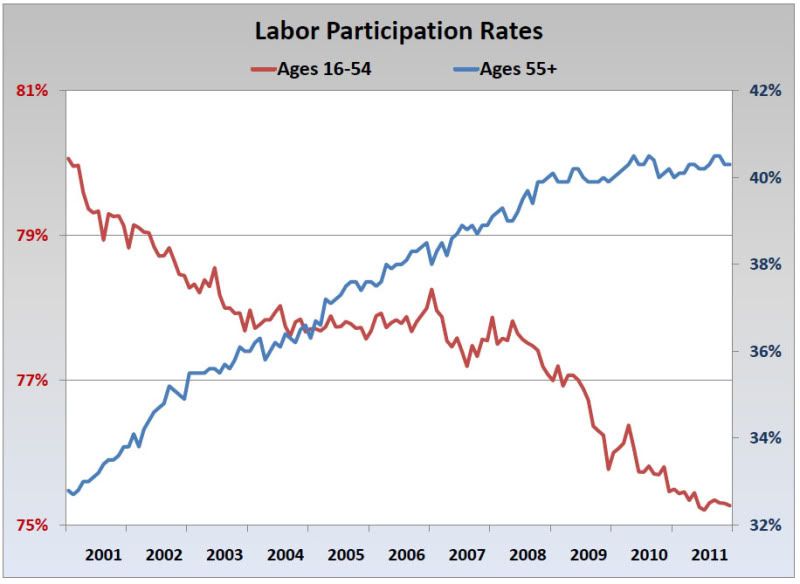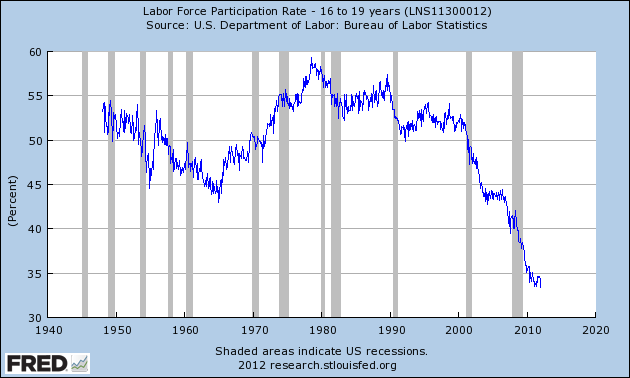(2 pm. – promoted by ek hornbeck)
There appears to be a lot of confusion and debate concerning the shrinking labor force participation numbers. People seem to have very strong opinions on both sides.
On one side you have the people who believe that the government is messaging the data to hide the unemployment rate by simply not counting unemployed people.
To these people I say: if it is a conspiracy it is a poorly concealed one, since the topic is debated even in the news media.
On the other side you have two groups: a) those who believe that people are simply retiring early, or b) that this is nothing more than a continuation of a long-term trend.
It is this latter group’s beliefs that I would like to address directly
First of all, the belief that the shrinking size is simply people retiring early to enjoy “the good life” is a nice thought.
It also has nothing to do with reality.

Considering all the retirement savings of Baby Boomers that were wiped out in the 2008 crash and the ongoing housing market bust, it would be foolish to think that Boomers are suddenly more able to afford retirement.
Surely some are retiring early because they were laid off and have little hope of landing another decent paying job. But that is being more than offset by those who simply have to keep working past retirement age.
The reason for the shrinking size of the workforce can be found in the youth.

That leaves open the debate of “why”. Why is the younger generation dropping out of the labor force at such a high rate? Especially when the economy has been adding jobs for several years now?
Some have pointed to a longer-term trend.
Looked at this way there have been two major changed in the participation rate. One is the falling rate for teens and young adults. This has been falling since about 1980 and academic economist have been studying it for years. The overwhelming conclusion has been that it was due primarily to education, in that youths found the opportunity cost of working rather than improving their education and/or preparation for college was too high.
Yes, that is indeed one way that you could look at it. There is also evidence that the young are staying in school longer, and that we should consider this to be a good thing.
On some level, this argument has validity.
But on a realistic level, it fails. The opportunity cost of working is high because there are fewer opportunities.
According to the NY Times only 53% of college graduates from the classes 2006-2010 are employed full-time. Even recent graduates who are working will make 10% less in their first job than graduates from just a few years ago, down to $27,000 a year.
Every economic recovery sees job growth in temporary and part-time work first, before companies hire full-time. This recovery is no exception. Thus you see college graduates working temporary and part-time jobs.
However, what we are talking about is a matter of degree.
For instance, a 5% unemployment rate and a 10% unemployment rate both mean millions are unemployed, just like heart-burn and a heart-attack both have the word “heart” in the description.
So when someone says this is just a continuation of a long-term trend you have to ask yourself two questions: a) is the trend a good thing? and b) is the curve of the trend steady?
The answer to both questions is; no.
A individual who has a career setback as a youth is a tragedy. An entire generation that has their career’s delayed or sidetracked is a disaster.
The business leaders at the World Economic Forum (WEF) know why it matters: Young people who were unemployed for a long time will earn less throughout their whole lives.
They will be less employable. They won’t have the skills that business needs. They are more likely to have long-term health problems. And it can cause social unrest.
There’s a term for it: Lost generation.
In an age where more and more of the population will be retired, we can’t afford to have the young generation unable to find work to pay taxes. In the long-term, we are looking at an entire generation with fewer employable skills, thus impeding economic growth.
And then there are the short-term costs that become long-term costs.
Young men are already more likely to break the law than most; having more free time, more motive and less to lose hardly discourages them. Some researchers claim to have identified a causal link between increased youth unemployment and increases in crime, specifically property crime (robbery, burglary, car theft and damage) and drug offences. No such link is seen for overall unemployment. If the crime leads to prison, future employment prospects fall off a cliff.
Research from the United States and Britain has found that youth unemployment leaves a “wage scar” that can persist into middle age. The longer the period of unemployment, the bigger the effect. Take two men with the same education, literacy and numeracy scores, places of residence, parents’ education and IQ. If one of them spends a year unemployed before the age of 23, ten years later he can expect to earn 23% less than the other. For women the gap is 16%.
A “recovery” that drags out like this for many years has serious, long-term economic costs no matter how you measure it.
So the trend, when extended out for years like this, is not a good thing.
As for the curve of the trend, it has accelerated to the downside since the 2008 Depression hit, and that trend continues to get worse.



The charts above demonstrate why young people are so desperate to get college degrees – not having them has a very high employment cost.
However, the fact that even kids with bachelor degrees are struggling to get jobs that will enable them to pay off their enormous student debts leaves one to wonder who the joke is really on.
Plus there is the fact that there will never be a time when everyone can afford to go to college.
But these charts also demonstrate something else that is extremely important: the largest demographic that is dropping out of the labor force is those without bachelor degrees. Thus the theory that the youth are simply staying in college is no explanation for the dropping labor force participation rates.
So what does it all mean? It means the labor force is shrinking because kids today are living with their parents, unable to find jobs.
Yes, the anecdotes you hear are based on facts. And the trend is not a good thing.

3 comments
you bring it.
There are no stats indicating that instrumental year of workplace change, 2008.
So your job has been.
Outsourced to China/elsewhere
Replaced by automation
Eliminated in/by corporate mergers, technology
I am then working “temp” which means working well below my capacity and without benefits. Since downsizing corporate no longer has a functioning HR staff. It does not have sufficient management structure to train anybody to do anything thus driving up a requirement for ten years of experience in whatever and that is after a drug test, a background check to see if you every posted something about 911 truth and credit scores and or perhaps some other top secret Infraguard no work list we just don’t know about.
health care reform
(that is 0bummer to any of you great orange clap louder toadies)
I wonder how many 55 and up would have bailed out with Medicare at 55?
I know soooooooooooo many teachers who’ve been in the trenches for 20+++ years, who’d like to pull back AND that would create job openings …
and, since our health insurance is gonna run them about $1000/ month,
which is $12,000 a year,
which is 24 or 36 or 48 grand you need salted away just to PROTECT yourself from financial disaster when you’re 63 or 62 or 61
so they’re still working!
And Mr. Catfood Commission’s debtor prison / Greek philosophy / 0sterity / Wall Street economic policies make sure those 60 somethings don’t pull back and open up the job market a bit for those newbies.
thanks 0bummer.
it is going to be a PLEASURE writing in “Medicare ForALL” instead of wasting another vote on another Democratic sell out – the way I did from 1978 to 2008.
BTW – it is YOUR fault that the right wing keeps running further right, hence the thug nominee will be some batshit crazy NewtMitt-PalinPRick.
rmm.